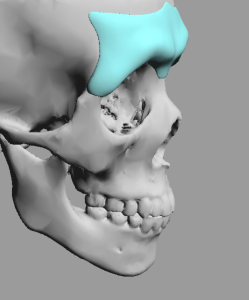While brow bone reduction is fairly well known because of the emergence of facial feminization surgery, less is known about its opposite cousin brow bone augmentation. While aesthetic brow bone augmentation has been done sporadically for years there has never been a completely satisfactory method for doing so. Different biomaterials have been used, usually hand crafted, and the method of placement of the implant has been through larger scalp incisions. All of these do not bode well for a predictable and significant brow bone augmentation effect.
All that has changed in the past decade with the introduction custom facial implant technology. With this approach performed implants can be designed and manufactured from the patient’s 3D CT scan for their specific aesthetic needs. This is of particular relevance when it comes to the complex shape of the brow bone area and the need to place the implant with the lest amount of scarring as possible. (endoscopic technique)


In the oblique view the male brow bone can appear to have a double bump due to the differences in the heights of the inner and outer mounds. Conversely in females there is little to no visible transition between the tail of the brow bone and the forehead.
While it is accepted that most male facial features are stronger or more pronounced than females, and the brow bones are no exception, there is more to it than just size. Men have a more complex topographic shape to their brow bones while women have a smaller more uniform shape. Such anatomic differences need to be built into custom brow bone implant designs to help maintain the augmented gender identity.
Dr. Barry Eppley
Indianapolis, Indiana







